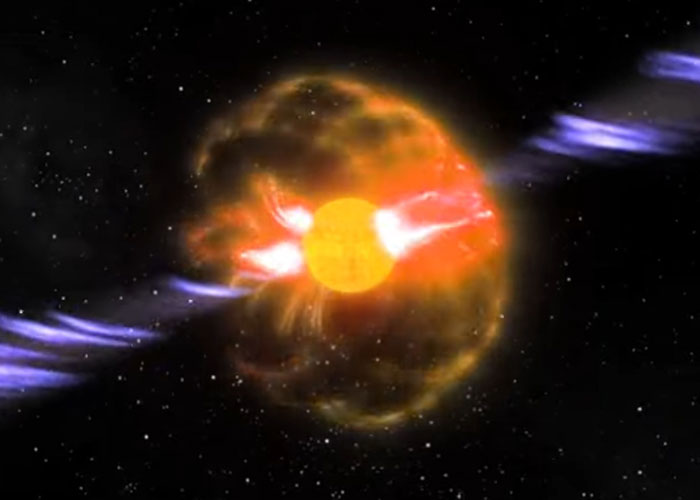
Radio Bursts From Nearby Star Leave Scientists Searching For An Explanation
Researchers have detected unprecedented radio signals coming from a previously dormant star.
Using Murriyang, CSIRO’s Parkes radio telescope, they recorded the magnetar—known as XTE J1810-197—sweeping the sky with powerful radio beams and circularly polarized light.
Magnetars are a type of neutron star with an ultra-strong magnetic field believed to be over a trillion times stronger than the Earth’s.
- Researchers have detected unprecedented radio signals from the closest magnetar to Earth, XTE J1810-197.
- The neutron star was captured emitting unique circularly polarized light.
- The signals indicate complex interactions at the magnetar's surface, challenging previous theories.
“Unlike the radio signals we’ve seen from other magnetars, this one is emitting enormous amounts of rapidly changing circular polarization,” said Dr. Marcus Lower, a postdoctoral fellow at Australia’s national science agency (CSIRO) who led the study.
“We had never seen anything like this before.”
Scientists discovered a previously dormant magnetar emitting circularly polarized light that appears to form a spiral

Image credits: SciTech Daily
The prevailing theory indicates that magnetars form by inheriting the magnetic field of the supermassive star from which they originated, as per Wired.
Detecting radio pulses from a magnetar is rare, and XTE J1810-197—the closest to Earth at 8,000 light years away—is one of just six known to emit such signals.
Still, researchers never expected to see it emit light that appears to form a spiral as it moves through space.
XTE J1810-197 was first observed to emit radio signals in 2003. Then, the magnetar remained silent for well over a decade. The signals were detected again in 2018 until they appeared again in 2024, this time with a unique pattern.
The magnetar—known as XTE J1810-197— is the closest one to Earth, located 8,000 light-years away from our planet
Image credits: Pexels/Drift Shutterbug
The findings shed light on the physics of intense magnetic fields and the environments they create.
“The signals emitted from this magnetar imply that interactions at the surface of the star are more complex than previous theoretical explanations,” the co-author of the study, Dr. Manisha Caleb from the University of Sydney, explained.
Though scientists don’t know what is causing this effect, they suspect plasma might offer an explanation.
“Our results suggest there is a superheated plasma above the magnetar’s magnetic pole, which is acting like a polarizing filter,” Dr. Lower added.
“How exactly the plasma is doing this is still to be determined.”
“Next thing you know, we’ll be getting updates from Mars via Bluetooth,” someone wrote
Very cool! Magnetars are some of the most bizarre objects in the universe - if one were orbiting the Earth at the same distance as the moon, its magnetic field would be strong enough to rip the iron out of our blood cells. They're very scary and also short lived - it's thought that they settle down into normal neutron stars after a relatively short amount of time. It's always fun to hear about new discoveries - it reminds us not to get complacent and arrogant about our knowledge of the cosmos. Great article, thank you for posting! 🙂
Very cool! Magnetars are some of the most bizarre objects in the universe - if one were orbiting the Earth at the same distance as the moon, its magnetic field would be strong enough to rip the iron out of our blood cells. They're very scary and also short lived - it's thought that they settle down into normal neutron stars after a relatively short amount of time. It's always fun to hear about new discoveries - it reminds us not to get complacent and arrogant about our knowledge of the cosmos. Great article, thank you for posting! 🙂












47
1